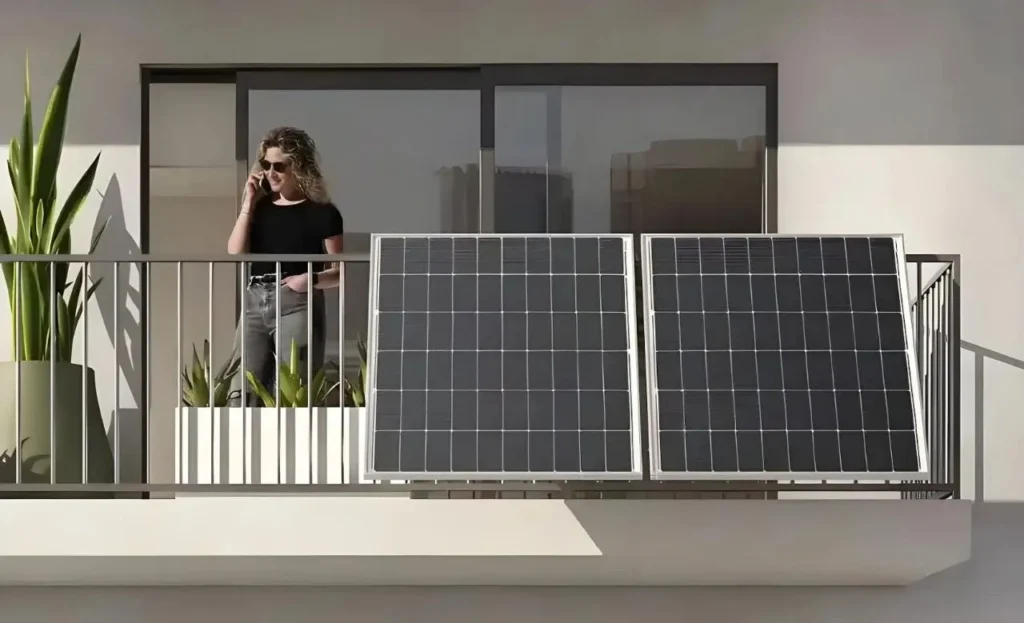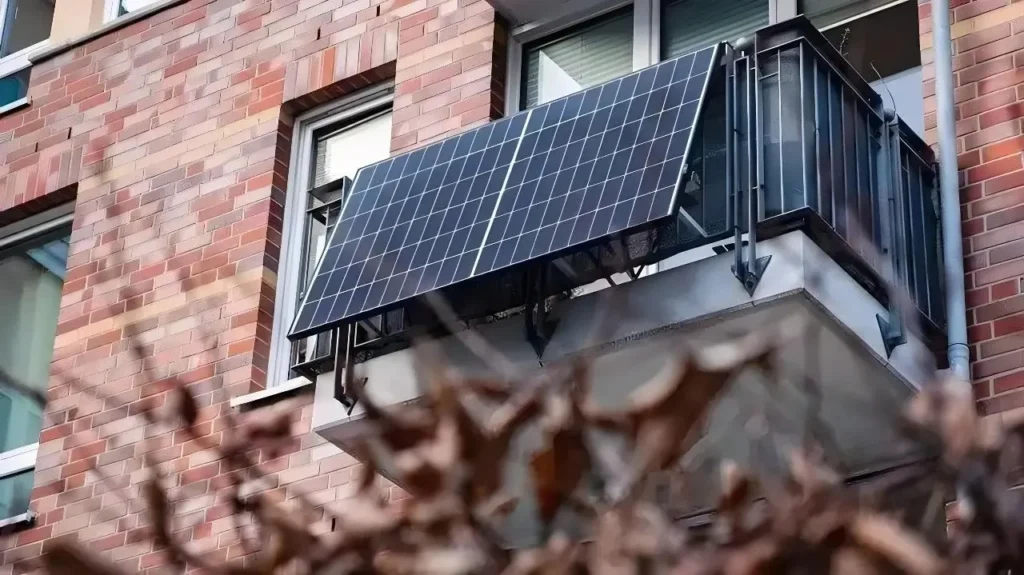Compare balcony solar policies in Germany, Italy, Spain & France. Explore incentives, costs, and adoption rates for urban renewable energy solutions.
Balcony solar refers to a distributed energy solution where small-scale photovoltaic systems are installed on balconies or building facades
Introduction: Balcony power plant refers to a distributed energy solution where small-scale photovoltaic systems are installed on balconies or building facades. Typically composed of 300W-3kW photovoltaic modules, micro-inverters, and energy storage devices, these systems connect directly to household circuits or the grid via sockets, enabling self-consumption. Their modular design adapts to urban spatial constraints without requiring structural modifications, making them particularly suitable for apartment dwellers. Given their cost-effectiveness, these systems are already demonstrating economic viability. This article examines the policies and current status of balcony power plant in Europe, a pioneer in this field.
▶1 Germany: Policy-Driven Growth
Germany, a benchmark for balcony power plant development in Europe, has a policy framework focused on lowering barriers to entry. The revised Renewable Energy Act (May 2024) exempts balcony power plant systems from grid operator registration, requiring only online registration with the Federal Network Agency. Tenants’ installation rights are protected under the Housing Rental Law, prohibiting landlords from unreasonably denying installation requests (a stringent provision). This policy drove a 47% year-on-year surge in balcony power plant equipment sales in 2024, with Q1 2025 additions reaching 1.2GW, accounting for 38% of new distributed PV capacity.
Technologically, Germany emphasizes the integration of microinverters with smart control systems. Munich-based SunRoof’s 500W all-in-one solar + storage system boosts self-consumption to 68% and uses AI algorithms to match real-time household demand. However, northern regions face challenges due to low annual sunlight (1,100 hours), extending payback periods to 8-10 years. In older buildings, wiring upgrades (22% of total costs) further hinder adoption.
The market is polarized: Cities like Berlin and Hamburg achieve installation densities exceeding 35 households/km² through community solar-sharing platforms, while rural areas face 4-6-month grid connection delays due to limited capacity. Future policies will pilot a “dynamic electricity pricing mechanism,” allowing balcony systems to participate in regional electricity markets.
▶▶1.1 Germany’s Residential Storage Market Declines, While Commercial and Industrial Sector Rises
Germany’s energy storage market has seen a significant sales decline, particularly in residential storage, which has stagnated. Meanwhile, the commercial and industrial (C&I) sector is gaining momentum, with large-scale storage also showing growth. The German Energy Storage Systems Association (BVES) maintains that the industry remains on a long-term growth trajectory despite consolidation but calls for faster approvals and improved regulations.
▶▶1.2 Residential Storage Hit Hardest
According to BVES’s latest analysis, the battery storage sector’s sales dropped sharply in 2024, with total industry sales falling 23% year-on-year to €12.5 billion. Residential storage sales dropped sharply by nearly 40%, from €11.1 billion in 2023 to €6.7 billion in 2024, driving the overall decline. BVES Managing Director Urban Windelen attributes this to reduced heat pump and home EV charger installations, citing falling energy prices, regulatory uncertainties (e.g., the Building Energy Act), and a sluggish construction sector. Thermal storage sales plunged from €7.3 billion to €4 billion, while electrical storage sales fell from €3.8 billion to €2.8 billion. Germany now has 1.7 million residential storage units, totaling 15GWh capacity and 9.5GW power. Windelen notes, “After a record year, a sales dip is typical,” viewing the decline as market consolidation rather than a crisis, with potential for recovery.
▶▶1.3 C&I Storage Shows Strong Growth
The commercial and industrial (C&I) storage market grew 23%, with sales rising from €1.3 billion to €1.6 billion, driven by corporate savings on electricity costs. Windelen states, “The industrial shift is gaining momentum.” Previously, C&I storage focused on sustainability ratings, but new momentum comes from integrating storage into EV and truck fleet charging hubs, where energy and cost efficiency, coupled with novel business models, enhance appeal.
▶▶1.4 Large-Scale Storage: Growth Amid Challenges
Large-scale storage and infrastructure sales grew 14% (€2.8 billion to €3.2 billion), a “critical signal” for a previously stagnant segment. New projects feature 4-8-hour batteries, shifting focus from power to capacity. Alternative technologies like redox-flow or zinc-bromine batteries are gaining traction. However, BVES warns of lagging grid connection processes and regulations. Windelen notes grid operators are unprepared for the surge in large-scale storage applications, lacking streamlined procedures. He disputes claims of “excessive” applications, projecting ~2.5GW annual additions.
▶▶1.5 Market Transformation Underway
BVES highlights ongoing price pressures, with German manufacturers losing share as storage becomes a price-sensitive “commodity.” Differentiation opportunities lie in software like energy management systems. Despite challenges, BVES forecasts 2026 sales to rebound to €14.2 billion, aided by regulatory tweaks like the Solar Peak Act (promoting midday solar consumption).
▶▶1.6 Policy Implementation Lags
Windelen criticizes bureaucratic hurdles: “We have solid regulations on paper, but execution is hampered by bureaucracy.” Key projects remain stalled, and the Federal Network Agency’s expanding role as a de facto legislator is “concerning.” He stresses the need for clear laws, investment security, and reduced red tape, especially in permits and building codes.
▶2 Italy: Tax Incentives as Leverage
Italy leverages Europe’s highest residential electricity prices (€0.28-0.35/kWh) and tax incentives to drive adoption. The upgraded Superbonus 2024 extends 110% tax credits to balcony power plant, allowing 10-year cost deductions, boosting average installations from 1.3kW to 2.8kW. In the first half of 2024, 0.89GW of new balcony PV was installed, with Puglia’s penetration hitting 17.3 systems/100 people—a record high in the EU.
High Storage Integration
CNCOB’s modular storage kits achieve 68% adoption rates, raising self-consumption rates to 83%. However, policy execution varies: Lombardy approves 92% of subsidies, while Sicily delays 30% of payments by over six months due to bureaucracy.
Innovative Models
Milan Energy Exchange’s “balcony power plant energy futures contracts” let users sell quarterly output at €0.05/kWh premiums. 2026 reforms will focus on grid capacity expansion, with a €470 million investment planned for southern grid upgrades.
Italy leverages Europe’s highest residential electricity prices (€0.28-0.35/kWh) and tax incentives to drive adoption. The upgraded Superbonus 2024 extends 110% tax credits to balcony solar, allowing 10-year cost deductions, boosting average installations

▶3 Spain: Steadily Advancing Grid Modernization
Spain promotes balcony power plant PV adoption through a two-pronged approach of production subsidies and grid service optimization. The 2023 “Localized PV Equipment Program” offers a 15% price subsidy for components with over 60% domestic content, reducing balcony-specific module costs by 22%. Distribution companies enforce a “15-minute grid connection” pledge, shortening the entire connection process to under 18 working days. In 2024, 65% of the 0.72 GW new installations came from the Madrid and Barcelona metropolitan areas.
Commercial and industrial applications drive growth: SMEs account for 54% of installations, deploying 50-100 kW systems on building facades, selling surplus electricity at €0.18/kWh under net metering policies. However, historic districts have installation rates below 12% due to heritage protection laws. Barcelona pilots a “virtual balcony” project using mirror arrays to boost solar gain by 30% on non-south-facing walls.
Technically, Catalonia Polytechnic’s Balcony PV Structural Safety Code mandates wind resistance up to Beaufort scale 12 (typhoon level), driving lightweight bracket material costs down 19%. A 2026 Mediterranean Islands Initiative will address frequency fluctuations from high PV penetration.
▶4 France: Style on the Outside, Savings on the Inside
France integrates balcony power plant PV into urban aesthetics, fueling demand via tax cuts and green finance. The revised 2024 Heritage Building Protection Act permits invisible PV panels on 79% of protected facades, reduces VAT from 20% to 5.5%, and introduces 1.8%-interest “Sunshine Loans.” Social housing projects comprised 37% of 2024’s 0.48 GW new capacity, with Paris’ 10th district (arrondissement) completing Europe’s largest public housing PV retrofit.
France’s strictest standards in Europe require smart-circuit breakers and remote-monitoring systems, cutting system failures to 0.7/year but raising single-unit costs 18% above Germany’s. Marseille and Lyon test “PV Community” models using blockchain for cross-building energy sharing, boosting returns by 11%.
Grid infrastructure remains a bottleneck: Provence’s transformers operate at 85% capacity, causing 8-month connection queues. A €420 million 2026 smart grid upgrade will focus on southern distributed energy integration.
France integrates balcony solar PV into urban aesthetics, fueling demand via tax cuts and green finance.Paris’ 10th district (arrondissement) completing Europe’s largest public housing PV retrofit.

▶5 Greece: PV + Desalination
Leveraging 1,800 average annual sunshine hours, Greece eases regulations for island PV markets. 2024 policies waive grid fees for systems under 3.6 kW and offer €800 subsidies to low-income households, lifting Crete’s household adoption to 21%. Athens Exchange launched a futures platform trading 6-month generation rights at €0.02/kWh premiums, averaging 120 MWh daily.
Grid stability challenges prevail: Aegean islands face 8% voltage fluctuations from 40% PV penetration, mandating storage. A 2024 pilot diverts 30% balcony PV output to small desalination units producing 2.5 tons/day.
The market sees increasingly financialized models: Piraeus Bank’s “PV Asset Securitization” lets users collateralize generation rights for loans. With 8% theft rates, a 2026 component ID system will be enforced.
Leveraging 1,800 average annual sunshine hours, Greece eases regulations for island PV markets.

▶6 Outlook
Core challenges: €23 billion in grid upgrades needed for mid-sized cities; the lack of EU-wide certification raises cross-border equipment costs 15-20%. The 2026-2030 market will grow 24-28% annually, transforming balcony power plant PV from “eco-decoration” to a European energy pillar.
Balcony power plant PV exemplifies a scenario where falling costs and widening price differentials make previously marginal projects viable again—putting industry players’ responsiveness to the test.





